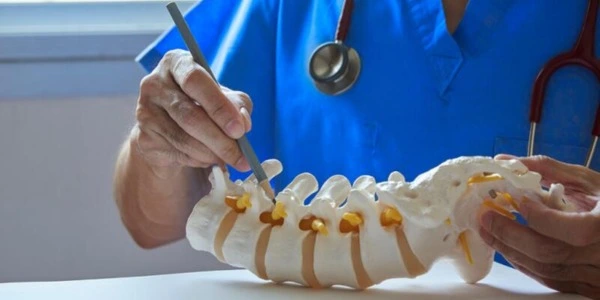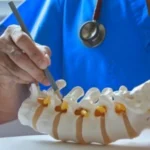Dealing with constant back pain and discomfort in the legs can greatly affect your quality of life. When methods like therapy and medication fail to ease the symptoms of a herniated disc, many people in Delhi NCR turn to advanced surgical solutions. One such option, Microdiscectomy, is a preferred minimally invasive procedure that offers relief to those struggling with nerve compression.
If you’re considering this treatment, consulting the best spine doctor in Delhi can help you understand whether Microdiscectomy is right for you. This guide explains everything about this modern procedure so you can make an informed decision for your spine health and long-term well-being.
Understanding Microdiscectomy: The Minimally Invasive Solution
What is a Microdiscectomy? A microdiscectomy is a type of surgery that removes small pieces of herniated disc pressing on spinal nerve roots. This method is different from traditional open spine surgery because it relies on smaller cuts and a microscope to reach the problem area.
The surgery deals with just the part of the disc pushing on the nerves, which often causes pain, numbness, or weakness. It takes out the damaged bit of disc leaving the healthy parts alone. Patients heal quicker with this technique than with older surgical methods.
Many spine doctors around the world now use this advanced method because it works well to treat lumbar disc herniation. It lasts 30 to 60 minutes and is often done as an outpatient surgery. This means patients can go home the same day.
How the Microdiscectomy Procedure is Performed
The Microdiscectomy Procedure uses a planned method to ensure patients are safe and achieve good results. Doctors give patients either local or general anesthesia during the surgery. The choice depends on each patient’s case and medical record.
The surgeon cuts a small incision about 1 to 2 inches, over the disc causing the problem. To get a better view, the surgeon uses a surgical microscope and shifts the muscle tissue aside to reach the spine. A bit of the vertebral bone known as the lamina, might need removal to make enough room to access the herniated disc.
After that, the surgeon removes pieces of the herniated disc pressing on the nerve. This step takes a lot of skill because avoiding harm to the healthy tissue nearby is crucial. Once the surgeon removes the disc fragments, they check to make sure the nerve root can move without any restriction. , they close up the incision using sutures.
How long does a microdiscectomy take? Doctors finish this procedure in 30 to 60 minutes, but some harder cases can take more time. Most patients spend around 2 hours at the hospital, which includes getting ready and recovering afterward.
Benefits and Success Rates of Microdiscectomy
This surgery comes with many perks compared to traditional open spine surgery. Its invasive method causes less harm to tissues and leads to less blood loss and smaller scars. People recover quicker and are often able to go back to their regular routines in a few weeks instead of waiting for months.
Microdiscectomy has a strong track record, with success rates between 76 and 100 percent as reported in medical research. Many patients feel noticeable relief from pain just days after surgery, but a full recovery can take a few weeks. Because of its high success rate, this surgery is a good option to try if other treatments have not worked.
The procedure works well because of its precise method. Surgeons take out only the damaged part of the disc while leaving the healthy part intact. This helps patients reduce pain and maintain spinal stability. The careful removal of the problem area leads to both high success and fewer complications.
Potential Complications and Risk Factors
Microdiscectomy is a safe procedure, but patients should know the possible risks before surgery. Dural tears happen in 0.7-4% of cases making them the most frequent issue. These are tears in the layer protecting nerve roots, and they recover without causing lasting problems.
About 5-15% of patients experience herniation again, and this often occurs during the first two years after surgery. This issue might need further treatment or another surgery. When proper surgical steps are taken fewer than 1% of cases face infection or bleeding, which are rare complications.
Nerve root injury does not occur often, but it is a serious problem that might lead to lasting nerve damage. Skilled spine surgeons work to reduce this risk by using precise surgical methods and advanced imaging tools throughout the surgery.
Microdiscectomy Recovery: What to Expect
Recovery after a microdiscectomy takes place over a planned period, though it can differ from person to person depending on their specific situation and how well they follow after-surgery instructions. The first stage of healing lasts about two weeks. During this time, people should avoid heavy lifting and activities that require a lot of effort.
During the first week after surgery, patients often feel some pain at the surgical site, which gets better over time with pain medication. Doctors recommend walking right after the procedure to help blood flow and avoid any issues. Many people can go back to desk jobs in one to two weeks, but those with more physical jobs might need four to six weeks before returning.
Recovery from Microdiscectomy happens step by step as patients increase activity levels. Physical therapy starts two to four weeks after the surgery and focuses on building strength in core muscles and helping the body become more flexible. Most people recover and return to their usual routines within six to twelve weeks.
The success of recovery relies on how well patients stick to their post-surgery instructions. Lifting heavy objects practicing poor posture, or ignoring recommended exercises can increase the risk of herniation returning. On the other hand, following these steps boosts recovery and leads to better results.
Advanced Care for Herniated Disc Problems
Herniated disc treatment options include both surgical and non-surgical methods. Before moving to Microdiscectomy most patients try out conservative approaches like physical therapy, pain relief medicines, or epidural steroid shots. Many people find these non-surgical treatments helpful enough that they don’t end up needing surgery.
Physical therapy has a key part in dealing with Herniated Discs. It focuses on strengthening the muscles that support the spine and keeps the back flexible. Tailored exercise routines work on certain muscles and also teach patients good posture habits to lower the chance of future problems.
Doctors use pain management methods like epidural steroid injections, nerve blocks, and radiofrequency ablation. These treatments sometimes ease pain or for a longer time and may even remove the need for surgery. But if a patient does not feel enough relief after 6 to 12 weeks of non-surgical methods, surgeries like Microdiscectomy become viable options to explore.
Expert Guidance for Spine Health and Treatment
To choose the Best spine doctor in Delhi, it is important to check their qualifications, experience, and how successful they are with patients. A good spine doctor should have advanced training in invasive procedures and a record of delivering positive results from Microdiscectomy surgeries.
Sant Paramanand Hospital in Delhi provides patients with modern spine care services. The hospital uses advanced surgical tools and employs skilled medical professionals focused on achieving the best results for patients. It emphasizes invasive methods following the top standards in spine surgery today.
To choose a Slipped & Herniated Disc Specialist in Delhi, patients need to look at things like board certification, spine surgery fellowship training, and connections to good hospitals. A good specialist provides a range of treatment choices and takes a cautious approach suggesting surgery when needed.
Patient Success Stories and Case Studies
Stories of real patients show how Microdiscectomy can change lives. Colleen, a 45-year-old teacher in Delhi, struggled with intense leg pain that made standing for long stretches impossible. When standard treatments didn’t work, she chose Microdiscectomy and saw her pain vanish in just a few weeks.
Marc, a 38-year-old software engineer dealt with herniated disc issues that made his work life hard. After having a Microdiscectomy, his life got better. It helped him get back to his busy job without any trouble.
Studies show that 80% of patients achieve good recovery after Microdiscectomy, while 20% face less ideal results. Giving focused post-surgery support and teaching patients plays a big role in helping them recover well.
Treatment Comparison Data Table
| Treatment Option | Success Rate | Recovery Time | Invasiveness | Cost Range |
| Microdiscectomy | 76-100% | 6-12 weeks | Minimally Invasive | ₹2-4 lakhs |
| Physical Therapy | 60-80% | 8-16 weeks | Non-invasive | ₹20,000-50,000 |
| Epidural Injections | 50-70% | 2-6 weeks | Minimally Invasive | ₹15,000-30,000 |
| Open Discectomy | 70-90% | 12-24 weeks | Highly Invasive | ₹3-6 lakhs |
| Conservative Care | 40-60% | Variable | Non-invasive | ₹10,000-25,000 |
Microdiscectomy FAQs
Is microdiscectomy painful? After surgery most people feel some discomfort they can handle. This pain is not as bad as what they felt before the operation. Taking pain medicine and following care instructions helps make recovery less uncomfortable.
How successful is microdiscectomy? The success rate falls between 76 and 100 percent. Many patients notice major pain relief and better movement. Success depends on picking the right patients, how well the surgery is done, and sticking to post-surgery care.
What are the benefits of microdiscectomy? Some main advantages include quick relief from pain, less disruption to tissues, faster healing, and a high chance of success. Since it uses an invasive method, it leaves smaller scars and reduces the chance of problems.
What complications might happen? Problems that might show up include dural tears, which happen in 0.7 to 4 percent of cases of repeated herniation in about 5 to 15 percent of patients as well as infection, bleeding, or nerve damage. Most of the time though serious issues ever happen when skilled surgeons perform the procedure.
How long does recovery take? A lot of people get back to their regular routines in 6 to 12 weeks. Those with desk jobs can start working again in 1 to 2 weeks, but those with physical jobs often need around 4 to 6 weeks to heal enough to return.
Who should consider microdiscectomy? People qualify if they have tried other treatments without success for 6 to 12 weeks, still face ongoing nerve problems, or struggle with major muscle weakness. Scans and tests must show the disc herniation and nerve pressure.
Making the Right Treatment Decision
Picking the right treatment for herniated disc symptoms means thinking about several things. Patients should try all non-surgical methods first unless there is an emergency like cauda equina syndrome.
A decision to have a Microdiscectomy needs a proper talk with a skilled spine doctor who can study your situation and give advice that fits your case. Things like age, health, how bad the symptoms are, and what your day-to-day life requires all play a role in deciding what to do.
To get expert spine care in Delhi NCR, Sant Paramanand Hospital provides modern treatments with capable doctors. The hospital focuses on patients and ensures recommendations match each person’s unique needs and condition.
If back pain or leg issues keep bothering you and basic treatments are not working, seeing a spine doctor can help you find out if Microdiscectomy or other treatments suit your condition. Acting means you recover quicker and get better results.




